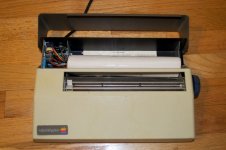krye
Well-known member
I scored this guy for only $60 bucks on eBay. I've seen them go for as high as $200-ish.

It does have some signs of age, but in surprisingly good condition for a 32-year old printer. It even still has a roll of paper in it as well as the paper roll holders. That has to be a bonus.

Unfortunately, I don’t have an interface card to test it. So I don't know if it even works. Not that I’m too worried about it. I have no intention of using it; it’s just nice to know I have one.
I didn't realize how small the silentype really was. It's surprisingly small compared to my Apple Scribe.


It does have some signs of age, but in surprisingly good condition for a 32-year old printer. It even still has a roll of paper in it as well as the paper roll holders. That has to be a bonus.

Unfortunately, I don’t have an interface card to test it. So I don't know if it even works. Not that I’m too worried about it. I have no intention of using it; it’s just nice to know I have one.
I didn't realize how small the silentype really was. It's surprisingly small compared to my Apple Scribe.

